

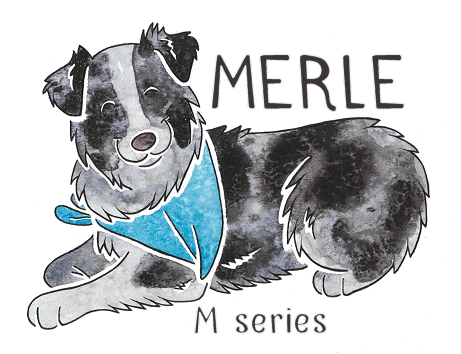

Already know what you're looking for? Quick Links |
| |

Introduction to the Merle Gene
Disclaimer
Merle is a fascinating and varied coat pattern, and there is no doubt that many of the merles shown further down this page are beautiful, unusual and exotic. However, the pictures and information are provided entirely for educational purposes and I do not in any way condone the breeding of dogs deliberately for colour, or breeding for colours or patterns that are not on the breed standard.
The primary concerns for any dog breeder must be health, temperament and conformation. Colour should only be a consideration where it is important for the breed standard. Special care must also be taken when breeding merles to avoid health problems, so merle is a colour best left to experienced dog breeders. If you are considering breeding a merle dog then please make sure to read all of the information below first.

** The information on this page provides a basic introduction to merle. New research has shown that the gene is actually more complex than this, so after you have read through the information here, you may wish to do further reading by clicking HERE to go to the new page on advanced merle genetics. I am keeping these sections separate to avoid confusion, and because for many of you, the information here will be enough. However, if you are considering breeding merles then it is important to understand the more advanced genetics **

The M locus is the home of the merle allele. Merle is dominant, and so denoted by the capital letter M. Non-merle is recessive, and denoted by m.
There are a number of different merle alleles, which are dealt with on their own page here. These are complicated and require a fairly advanced knowledge of genetics to understand, so I recommend continuing to read this page first to get a hang of the basics. On this page, I refer only to the standard merle allele (M), which produces the classic merle pattern.

Merle is interesting because there is usually a big phenotypical (visible) difference between heterozygous (Mm) merles and homozygous merles (double merles, MM) (see below).
The merle gene dilutes random sections of the coat to a lighter colour (usually grey in a black-pigmented dog), leaving patches of the original colour remaining. The patches can be any size and can be located anywhere on the dog, unlike the patches on a piebald dog (which are generally confined to the body and head). The edges of the patches may appear jagged and torn.
Merle affects eumelanin. That means that any black, liver, blue or isabella in the coat, eyes or nose will be merled, whether it's the whole
of the body, a mask on a sable, shading, brindle stripes, or even a saddle. Phaeomelanin (red) is not usually affected and will generally appear as normal, although there can be exceptions to this.
Health Issues
The merle gene is known to cause a number of health problems, mostly deafness and blindness, and also sun sensitivity and higher rates of skin cancer. These problems are unusual in heterozygous merles (Mm) but more common in
homozygous merles (MM). For this reason, two merle dogs should not be bred together, as a general rule, as this will likely result in some double merle puppies. There are some exceptions to this, which are explained on the Advanced page.
The reason merle can be problematic is it can cause lack of pigment in certain vital areas - the eyes and inner ears. Most heterozygous merles have plenty of pigment because they still have an
m (non-merle) allele to help them to make it, but double merles
often have large white areas where there is no pigment produced at all.
Breeds With the Merle Allele
The merle allele only occurs in a small selection of dog breeds. These include:
Australian Shepherd
It has also recently been bred into other breeds, including the Chihuahua, American Staffordshire Terrier, American Cocker Spaniel and Pomeranian.
Variation in Patching
The pictures above show the range of markings found in merles. The first dog has very few black patches, and they're mainly quite small. The second dog shows the normal
merle pattern - a mixture of larger and smaller patches, covering roughly 50% of the body. This pattern is generally the most preferred in breed standards. The third dog
has very large black patches, sometimes referred to as blanketing. The last dog is known as a minimal merle. It is almost completely black with just a very
small amount of merling. This pattern is generally discouraged because it can "hide" the merle gene if the black covers up all the merle in the coat (particularly when combined with white markings).
The dogs above are called "blue merles" because of the bluish colour between the patches in their coat. This is a widely-used term but is actually misleading. Technically they should be "black merles".
Their nose pigment is black and their eyes are brown or blue. They are able to make normal eumelanin in their coat, so their patches are black. If they didn't have the
merle gene, they would be solid black. "Blue merle" is misleading because it seems to say that these dogs have blue pigment (dd acting on black - see Dilution page), when in fact they have black.
An example of the genotype of one of the above dogs would be: BBDDEEggMmSSKBKB (most of these aren't necessarily homozygous, but I
will assume they are for ease). The genotype translates as: no liver colour (BB), no dilution (DD), no mask or recessive red (EE), no greying
(gg), merle (Mm), no white spotting (SS), and solid black (KBKB).
Variation in Base Colour
The base colour (the diluted parts) on a merle can vary greatly, from a very pale "powder blue" to a dark grey with a ticking pattern on the grey areas, known as a muddy merle or ticked merle. Note that this "ticking" is not the same as the ticking that appears on the white areas of a dog due to the ticking (T) gene, and doesn't have the same genetic basis. Very pale dogs can appear almost white with black spots and can look very similar to a harlequin Great Dane, although only that breed actually has the true harlequin gene. The illustrations on the left and right above show the extremes of the base coat colour.
Eyes and Noses
The random coat dilution caused by merle also affects the eyes and nose. The eyes may be all or partly blue, and the nose may be all or partly pink. Above are examples of "butterfly" noses on merles,
which are partly pink. Not all merles have blue eyes or pink noses though, and merles with heavy dark patching are more likely to have normal eye and nose pigment.
The harlequin Great Dane here also shows a butterfly nose and wall eyes (one blue, one brown). Harlequin is a modified type of merle where the areas between the patches are diluted completely to white.
See the Merle Modifiers page for more information.
Dilute Spots
Due to the unstable and variable nature of the merle gene, sometimes merles have patches that are only partially diluted, and are between the base and the patch colour. These are known as dilute spots, and they may sometimes appear brownish. The Australian Shepherd above has a large dilute spot on its knee.
We talk about coat colour being "diluted" in a merle, but note that dilute spots don't have anything at all to do with the Dilution gene (d), and are just a normal variation of the merle pattern.
Hidden Merle
Merle can be hidden through the recessive red allele (ee, see the E locus page for more info). Recessive red dogs are unable to produce any eumelanin pigment in their coat, making them solid red (phaeomelanin). Phaeomelanin cannot be merled (at least not in a heterozygous merle - see below for examples of double/homozygous merles, where the merling affects all pigment), so a recessive red dog with the merle allele will just appear to be a normal clear red. Sometimes a recessive red merle will have blue or partially blue eyes, but otherwise there may be no indication that the merle gene is present. These dogs are sometimes called "phantom" merles.
Recessive red and merle can be a dangerous combo, simply because you may not know that a recessive red dog is a merle. The two genes occur together in a number of breeds, including Pomeranians and Chihuahuas, and in such breeds it's advisable to never breed a clear red dog (with any merle in its ancestry) to a merle, due to the risk of accidentally breeding double merles.
Merle can also be hidden by long or wire coats, although the merling should be obvious at birth or if the dog is shaved down.
Double Merles
"Double merle" is a term often used for a merle that is homozygous. That means it has two copies of the dominant M gene, so its genotype is MM. This can severely impair its ability to make pigment. On a double merle, both eumelanin and phaeomelanin pigments are affected.
Double merles are typically mostly white and may have merle patches on the head and sometimes the body. They do not necessarily have the allele for piebald (although if they do, they're likely to have even more white than double merles without a white spotting allele), but the MM genotype causes loss of pigment to such an extent that it tends to remain only on the upper areas of
the dog - the top of the head, the back and the base of the tail, similar to the extreme spotting pattern. Sometimes double merles are even born
completely white. The nose is generally mostly or all pink, and the eyes are generally wall or blue (see eye and nose pages).
This Dachshund is a blue (black) double merle with tan (called a double "dapple" in this breed). She has a large amount of colour on her body, but she does have a lot of white on her face. The eye on the side with the white is
blue because of the lack of pigment, and she has a butterfly nose.
This Border Collie type has a typical double merle coat pattern. However, the full pigment on the nose and around the eyes
suggests that she may in fact just be a high-white normal merle with extreme spotting. It would be unusual for a double merle to have so much pigment.
Here we have a probable harlequin double merle. Harlequins are merles with a modifier that changes the way the merle looks (see the page on merle modifiers). The same principles
therefore apply to harlequin double merles as do to normal double merles - the patches will generally be smaller and confined to the head and the back, and there will often be a more pronounced
lack of pigment around the eyes and nose.
The breeding of double merles is generally problematic, not just because double merle dogs rarely match breed standards (for example,
a double merle Dachshund like Casey above would be disqualified for too much white and lack of pigment), but also because of the health problems linked to them. Some double merles
are perfectly healthy, but eye defects and deafness (due to lack of pigment in parts of the inner ear) are common, as well as sunburn and skin cancer on exposed pink areas. See the page on
health problems for more information.
Stanley, the Dachshund above, has relatively little white for a double merle. However, he was born with an abnormally small eye (micropthalmia), which has had to be removed. This is sadly a known issue in some double merles.
At the opposite end of the double merle scale to Casey and Stanley is this completely white Dachshund, Noddy. Noddy is both deaf and blind, showing the very serious consequences of irresponsible double merle breeding.
A double merle can only be bred from two merles, as it requires an M gene from each parent. However, occasionally merle can be hidden by other genes. A recessive red dog will not display any merle
because it is unable to make eumelanin in its coat, and the merle gene only affects eumelanin (black, liver, blue and isabella). A clear sable (
dog with a red coat due to the sable gene, but no visible black sabling) will also
not show any merling because there is no eumelanin to be merled, unless it also has a mask (which does show merling). Shaded sables will often show merle
at birth, but it tends to fade as the dog grows up, so all that remains on an adult is usually a few darker brownish patches on the coat (which can be
hidden very easily by long fur). The greying gene can also make it very difficult to see merle markings, as can the dilution gene (dd), because it dilutes
the patches so that there is less of a distinction between them and the base colour. Merle can be very difficult to see on a brindle too, due to the stripes. Lastly, merle can be hidden if the dog has very heavy markings, so a blue merle could appear almost completely black if the patches are large enough - you may need to look very closely to see the grey areas.
Let's quickly have a look at some Punnet squares again to see how merle breeding works. You may need to go back to the Breeding page to understand
this if you're not sure what a Punnet square is.
Merle puppies are circled in blue and double merles are circled in red. Non merles are not circled.
It's clear from this that breeding a double merle to a non merle is the only way to get a completely merle litter. Double merle to non merle
and merle to non merle are the only "safe" breedings - i.e. the only ones which cannot produce double merle puppies. Breeding merles of any sort (single or double) together
is always risky. I haven't included a Punnet square for a double/double breeding, but that one is easy enough to work out - each parent can only
possibly pass on the M gene, so all puppies will be MM (double).
"Lethal White"
Double merles are often referred to as "lethal whites". This is an incorrect term. The merle
gene is not lethal, however it is problematic, as explained above. Lethal white is a completely separate gene that does not occur in dogs. It's found in horses, where it is recessive, unlike the dominant merle gene in dogs. Lethal white (also known as Overo Lethal White Syndrome)
kills 100% of horses that are homozygous for the gene. A lethal white will be completely white with blue eyes. It is unable to produce any pigment, like an albino,
and because in horses the cells in the intestine are linked (embryonically) to the cells which control skin pigment, they don't develop properly. The intestine is therefore
contracted and lethal white foals are unable to pass faeces. This eventually results in death. There are no genes equivalent to this in dogs.
Merle Look-A-Likes
Sometimes black and white dogs with heavy ticking or roaning can be mistaken for merles. The main giveaway is that a ticked or roaned dog
will have very uneven grey areas, with flecks of white showing through. Also, if the dog has tan points, they will be ticked too (if they're on the "white" areas rather than the black patches), whereas in a merle they would be solid, and
the patches on a blue roan or ticked dog will be more regular than on a merle (appearing only on the back and head in the piebald or extreme white pattern, rather than all over the dog). In addition, if the dog
has a butterfly nose or any blue in its eyes then it is most likely a merle as these pigment issues do not generally affect roaned dogs.
All of these dogs are merle "look-a-likes", but none of their breeds (English Cocker Spaniel, Australian Cattle Dog and Basset Bleu de Gascogne) actually carry merle:
We've now covered the basics of merle and how it works, and unless you have a particular interest in breeding merles, that might well be enough. However, it turns out that there isn't just one version of the M allele, but a number of different ones that produce different effects in the coat (both on their own and in combination with each other).
For some more examples of merle on different coat colours and types, click here to go to the "Merle (continued)" page. To expand your knowledge of merle and find out more about the different merle alleles, click here to go to the new page on advanced merle genetics. Quick Summary!
The M locus consists of M (merle), and m (non-merle). A merle dog has problems making eumelanin pigment, causing random patches of dilution in the coat. Most normal-looking merles are Mm, as two copies of the merle gene (MM) generaly results in double merle. Double merles have large amounts of white in their coat and deafness and eye abnormalities are common.
Merle can be completely hidden by recessive red, as recessive red dogs can't make eumelanin pigment and merle only affects eumelanin. A recessive red merle is sometimes known as a phantom merle. Further Info and Links
The gene causing merle in dogs is PMEL17, also known as SILV. Mutations in SILV have been detected in mice, chickens, horses and they are also thought to occur in humans. In horses, SILV affects eumelanin pigment only and causes the colour "silver" (see link below), and in chickens it causes dominant white, "dun" and "smoky" variations.
Note that due to patents in place, not all laboratories will test for the Merle gene.
Links to studies:
** Please note that I am not a research scientist, and the information on this page comes from my own knowledge and observation of dogs, observational and testing data provided via e-mail by site visitors, any research papers linked on the page, and the information provided by Dr Sheila M. Schmutz on her excellent website http://homepage.usask.ca/~schmutz/dogcolors.html
All links are provided for advertisement and/or information purposes only, and I am not affiliated with any genetics testing labs or other companies.
For further genetics resources, see the Links page


Catahoula Leopard Dog
Norwegian Dunker
Border Collie
Hungarian Mudi
Cardigan Welsh Corgi
Collie (Rough and Smooth)
Shetland Sheepdog
Dachshund (known as dapple)
Beauceron (known as harlequin)
Bergamasco
Pyrenean Shepherd
Great Dane

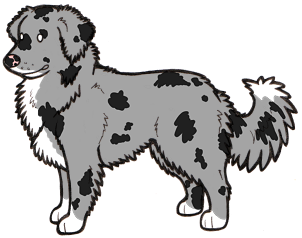
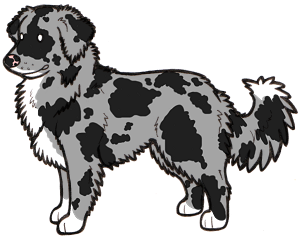
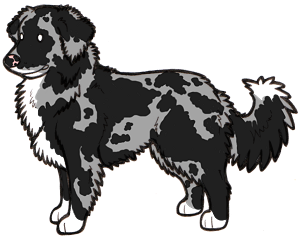
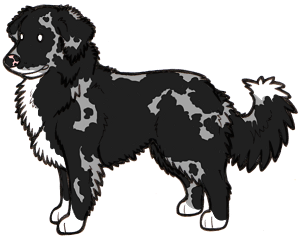

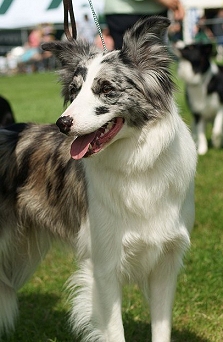
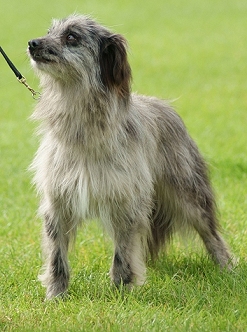
Two solid blue merles (the Border Collie also has white in the irish spotting pattern and bronzing on its side, which can sometimes be connected to the merle pattern).

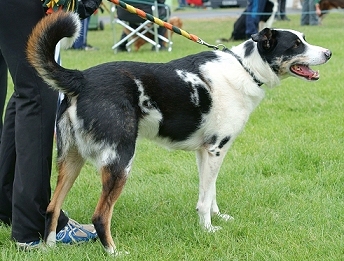
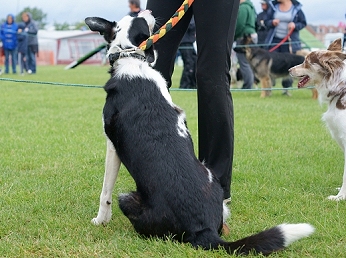
This mixed breed has very heavy patching, and one side of the dog is almost completely solid black. The merling is only visible on the right side (first photo). This dog also has tan points (atat) and white spotting
in the irish or pseudo-irish pattern.

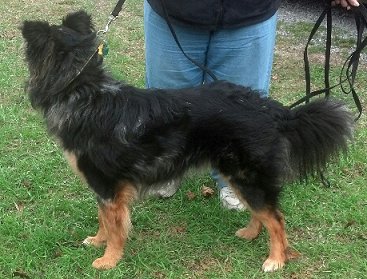
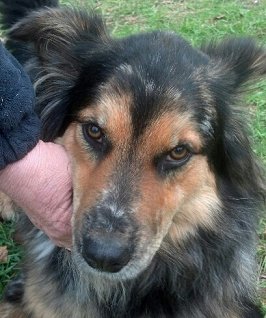
These photos, submitted by Karen Palmer, show a dog with very little visible merling. Most of the merling is on the muzzle, with much of the rest of the dog appearing almost solid black-and-tan. These dogs are sometimes described as "cryptic merles", but this term isn't accurate, as we will explore later.

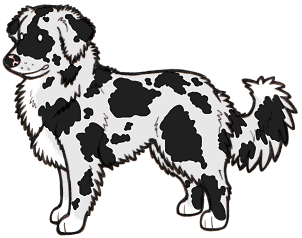

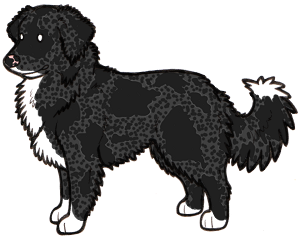
In at least some breeds, the base colour on a merle also seems to darken as the dog ages.
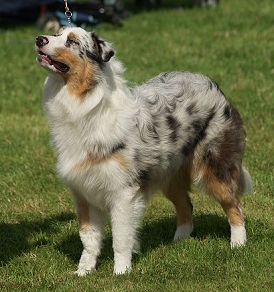
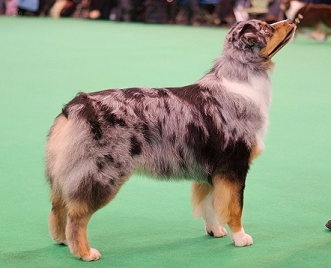
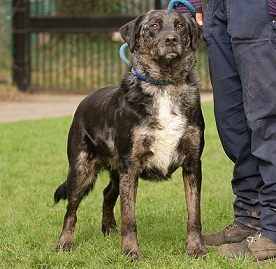
Real life examples of the variation in base colour of merles. The dog on the right also appears to have ghost tan, which can become more obvious in a merle as some of the black pigment is stripped away.

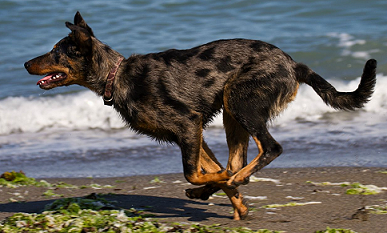

A "muddy" base coat is fairly common in Beaucerons, such as the beautiful example here (submitted by Tanya PS). Interestingly, merle Beaucerons are known as "harlequins". This simply comes from a French term and is not related to the true harlequin patterning seen in Great Danes.

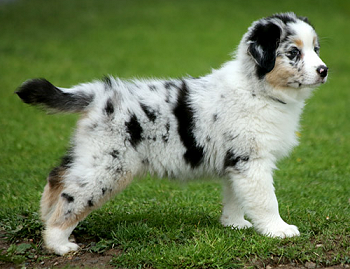
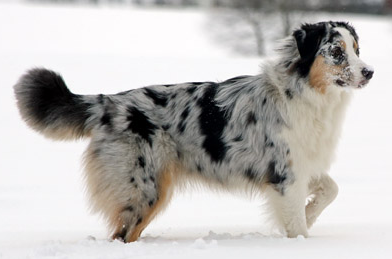
Kiwi the Australian Shepherd shows how merle can darken with age. The second photo shows her at 10 months old. Photos submitted by Jessica Pilhede.

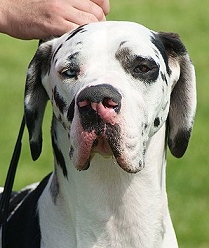





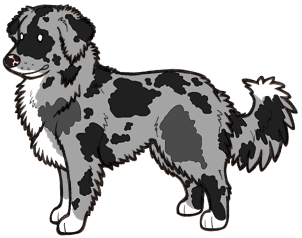
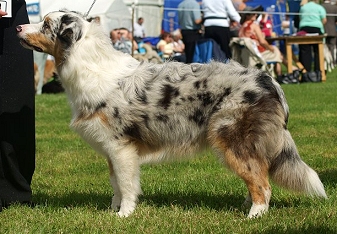

Clear sable can "hide" merle almost as effectively as recessive red. A clear sable is one with no dark (eumelanin) hairs in its coat, and clear sables may be almost indistinguishable from recessive reds. For this reason, care should be taken when breeding any solid red dogs in breeds where merle is present.
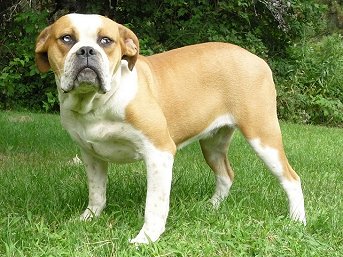
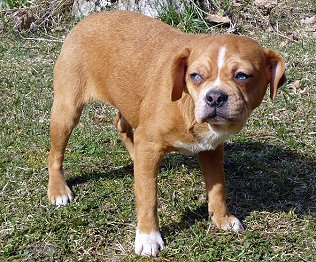
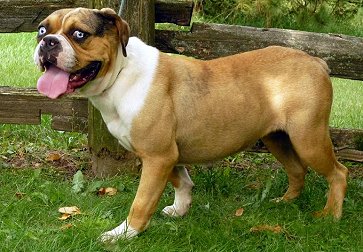
These three dogs are all phantom merles. Juniper (black pigment, left) and Pekoe (blue pigment, middle) are either sables or recessive reds, and have no visible merling at all. Their blue eyes are a clue that they are genetically merle, although blue eyes can also occur entirely separately from the merle gene, so can't be taken as solid proof. Sometimes a light merling pattern can be seen at birth, but this generally fades as the dog ages. Sequoia (right) is a sable merle, and has some very faint visible merling on the head and side. All of these photos were submitted by Laura Kelsh.
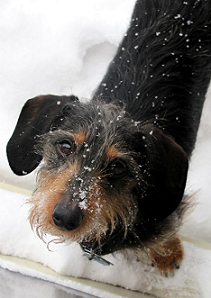
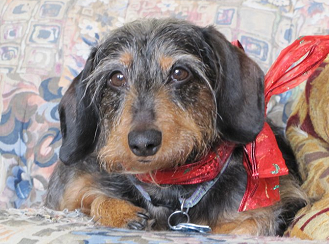
Merle in Dachshunds is known as "dapple", but it's the same gene as merle in other breeds. This Wirehaired Dachshund is actually a dapple (merle), but it's very difficult to tell due to his coat type. Even his eyes are solid brown and don't give any clues as to his true coat pattern. Photos submitted by Abby L.

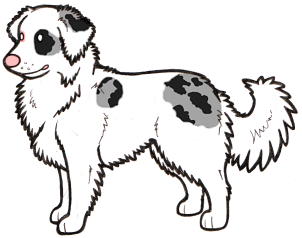
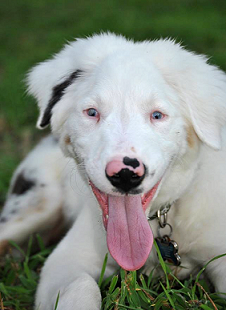
Blitz the double merle Aussie, submitted by Jennifer Mclean. Blitz is deaf and has impaired vision. As you can see, Blitz's eyes are small and not formed properly (known as micropthalmia).

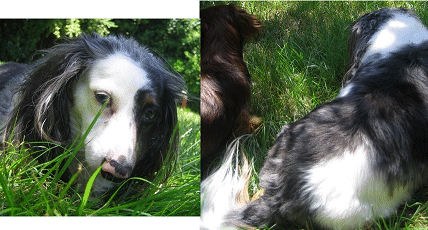
Casey the longhaired Dachshund, photos by Mascara from the PKC forum

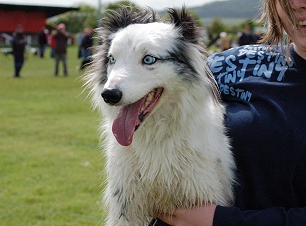
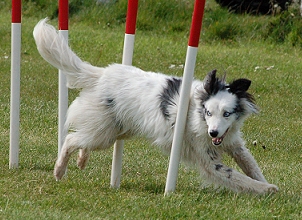
Photos by Cat of Dog Rad Design

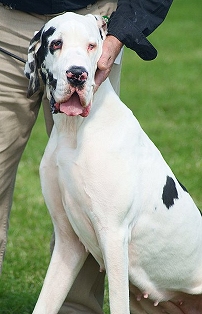
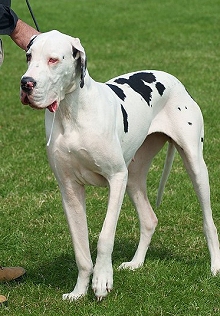

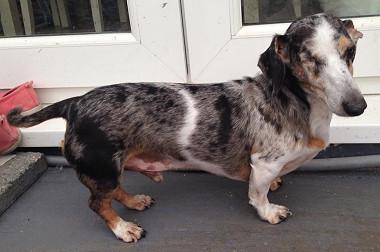
Photo provided by Tina West

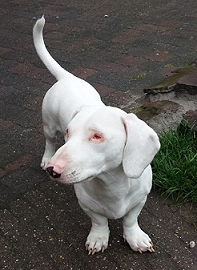
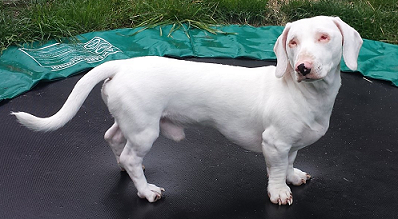
Noddy the Dachshund. For more photos please see: http://www.facebook.com/noddyensaartje

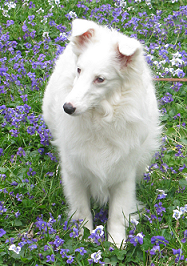
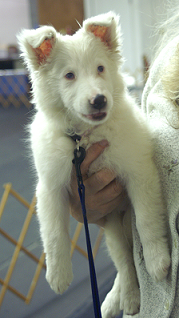
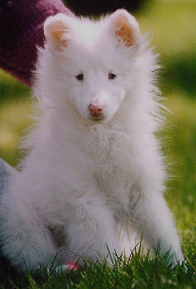
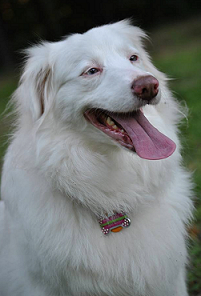
White double merle Shelties Sasha and Vixen, submitted by Nancy Edmonds, and Muffin the deaf liver-pigmented double merle Australian Shepherd, submitted by Jennifer Mclean.

All of these mean that anyone who breeds merles must be very careful to avoid breeding double merle puppies. Sometimes the hidden merles described
above have a blue eye or a butterfly nose, which give away their merle gene, but often there is no sign at all that they are merle. If such a dog is
accidentally bred to another merle, some of the puppies will be doubles.
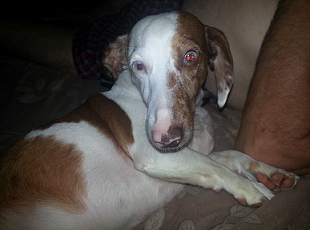
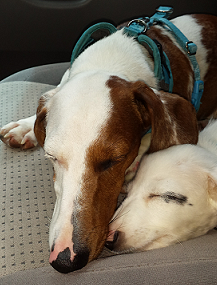
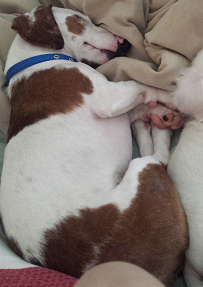
As you can see from these two Dachshunds, sable and recessive red can hide merle very well. Both dogs look like red piebalds, however the "split face" marking seen on both is strongly associated with double merle patterns, as are the blue eyes, and indeed both are double merles. The first photo was submitted by Dee Allison and the others by Stephanie.


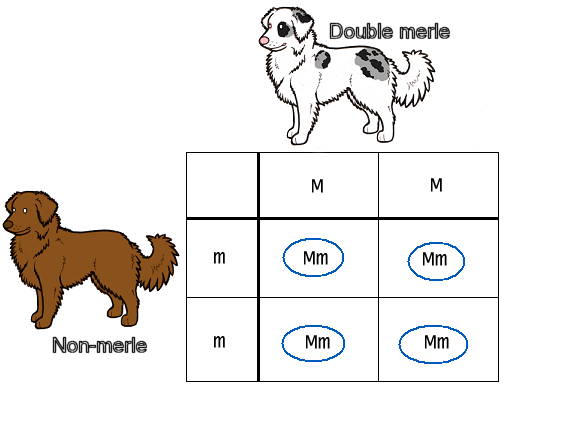

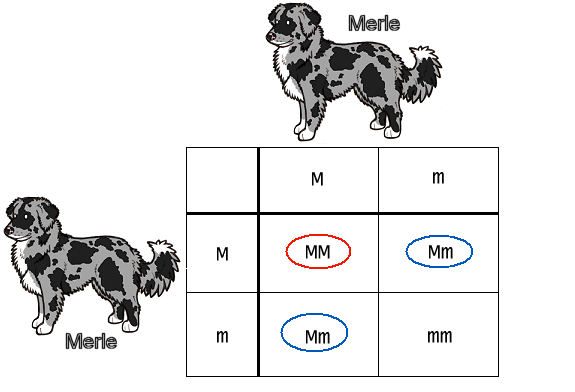

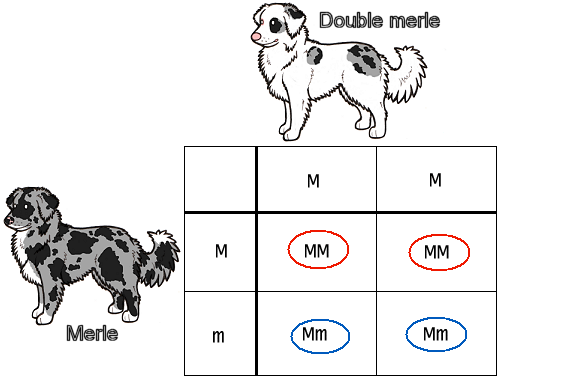



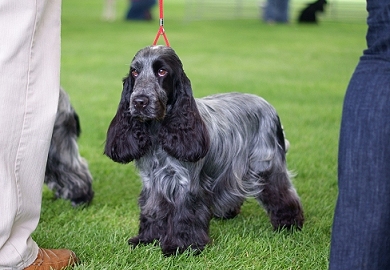

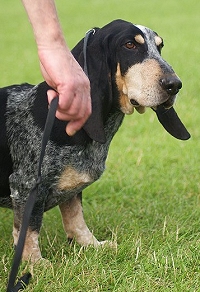


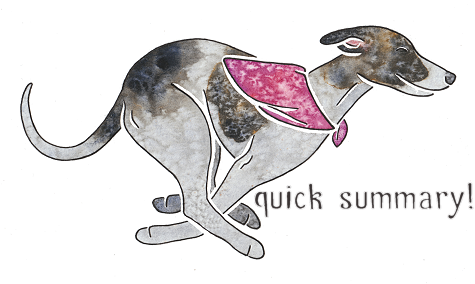
No time to read the whole thing? Here's the quick version!
All merles may have blue or partially blue eyes, and pink or partially pink noses.

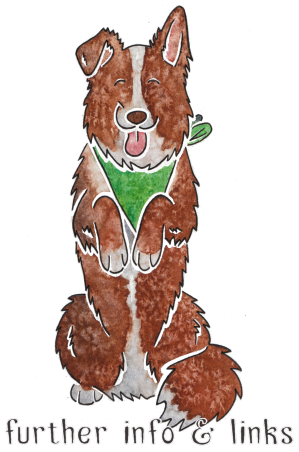
Retrotransposon insertion in SILV is responsible for merle patterning of the domestic dog: http://www.pnas.org/content/103/5/1376.long
A missense mutation in PMEL17 is associated with the Silver coat color in the horse: http://www.biomedcentral.com/1471-2156/7/46

